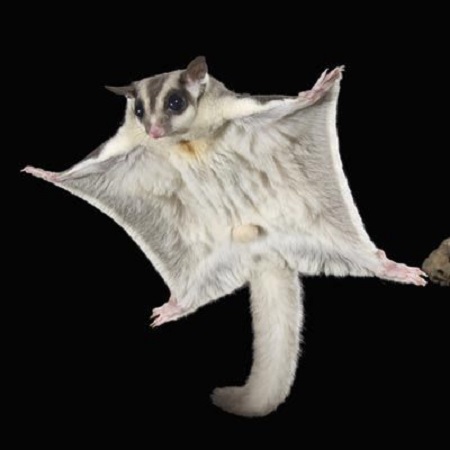
For those seeking an extraordinary and enchanting pet, the Krefft’s Glider (Petaurus notatus) presents a captivating option. Hailing from the dense forests of Australia, these charming marsupials offer a fascinating glimpse into the world of gliding mammals. In this article, we’ll delve into the basic care practices and ideal situations for keeping a Krefft’s Glider as a pet, allowing you to embark on a rewarding journey as a responsible pet owner.
Unveiling the Krefft’s Glider
Krefft’s Gliders, also known as Sugar Gliders, are small, nocturnal marsupials renowned for their captivating appearance and unique ability to glide through the air. Their name stems from their affinity for sweet foods and their membrane-like gliding membrane, which stretches from their wrists to their ankles, enabling them to glide gracefully from tree to tree.
Basic Care Practices
1. Enclosure: A spacious and vertically oriented enclosure is crucial for the Krefft’s Glider. A tall cage with horizontal bars for climbing and gliding is recommended. Ensure the cage has enough space for exercise and play.
2. Diet: A balanced diet is essential for the health of your pet glider. Their diet typically consists of a mix of fruits, vegetables, protein sources, and a specialized glider pellet or powdered diet. Offer fresh water daily.
3. Socialization: Krefft’s Gliders are social animals and thrive in pairs or small groups. Consider adopting at least two gliders to prevent loneliness and provide companionship.
4. Enrichment: These inquisitive creatures love mental and physical stimulation. Provide toys, climbing structures, and hiding spots to keep them engaged and active.
5. Nocturnal Lifestyle: Keep in mind that Krefft’s Gliders are nocturnal, which means they are most active during the night. Their sleeping quarters should be kept dark and quiet during the day.
6. Bonding: Bonding with your gliders requires patience. Spend time with them during their active hours, offering treats and gentle interactions to build trust.
Best Situations for Krefft’s Glider as a Pet
Experienced Owners: Krefft’s Gliders require specialized care, making them ideal for experienced pet owners who are dedicated to meeting their unique needs.
Time and Commitment: These charming pets demand time, patience, and daily care. Prospective owners should be prepared to invest effort in their well-being.
Appropriate Environment: Creating a habitat that mimics their natural forested environment is crucial. This includes providing vertical space, climbing opportunities, and proper temperatures.
Companion Animals: Gliders are social creatures that thrive when they have a fellow glider as a companion. A bonded pair or small group is recommended.
Nocturnal Lifestyle Compatibility: If you’re a night owl or have a flexible schedule that allows you to spend time with your gliders during their active hours, owning a Krefft’s Glider could be a perfect match.
Conclusion
Owning a Krefft’s Glider is a journey into the unique world of marsupials with extraordinary gliding abilities. As responsible pet owners, it’s our duty to provide them with a safe, stimulating, and loving environment. From their specialized diet to their need for social interaction, understanding and meeting the requirements of these captivating creatures will result in a rewarding and enriching experience for both gliders and their human companions.
10 Fun Facts About the Krefft’s Glider
Flying with Style: Despite the name “Sugar Glider,” these marsupials don’t fly; they glide. They use a membrane called the patagium, stretching from their wrists to their ankles, to glide effortlessly from tree to tree in search of food and shelter.
Sweet Tooth: Sugar Gliders have a strong affinity for sweet foods, which is reflected in their name. They feed on nectar, sap, and sweet fruits in the wild, but in captivity, their diet should be carefully balanced to mimic their natural intake.
Nocturnal Marvels: These adorable creatures are strictly nocturnal, meaning they are most active during the night. Their large, round eyes help them navigate the darkness, and their keen senses of smell and hearing aid in finding food and avoiding predators.
Social Butterflies: Sugar Gliders are incredibly social animals. In the wild, they live in small family groups, and they thrive when kept in pairs or small colonies as pets. They groom each other, sleep together in cozy nests, and communicate with various vocalizations.
Vocal Repertoire: Speaking of vocalizations, Sugar Gliders have an interesting range of sounds. They can chirp, bark, and hiss, which they use to communicate with each other. These vocalizations help establish territory and express emotions.
Extraordinary Gliding Skills: Sugar Gliders can glide impressive distances – up to 150 feet in a single glide! They use their tail to steer and control their direction during flight. This ability helps them cover more ground to find food sources and evade predators.
Unique Family Structure: Unlike other marsupials, Sugar Gliders have a different method of reproduction. Female Sugar Gliders have two uteri and can become pregnant in both simultaneously. This unique reproductive strategy helps ensure the survival of the species in the wild.
Scent Marking: Sugar Gliders have scent glands on their foreheads and chests. They use these scent glands to mark their territory, communicate with other gliders, and leave a trail to navigate through their environment.
Longevity: In the wild, Sugar Gliders typically have a lifespan of around 5 to 7 years. However, in captivity, with proper care and attention to their needs, they can live longer, sometimes reaching 12 to 15 years.
Australia’s Native Gems: Krefft’s Gliders are native to Australia, specifically found in the eastern and northern parts of the continent. They are named after Gerard Krefft, a 19th-century German-Australian naturalist who contributed significantly to the study of Australian wildlife.
Related Articles & Free Email Newsletter Sign Up
Guinea Pig Bathing Guide: When and How to Keep Your Furry Friend Clean


Comment here